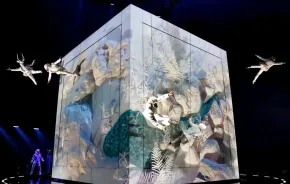Discover the marine celebrities of the Salish Sea
Few things are more thrilling than seeing an orca whale in the wild,
and we are lucky enough to live in a region where that's possible.
Nicknamed "killer whales" even though they are usually gentle around
people, orcas weigh from seven to 10 tons and can grow up to 27 feet
long, which makes them colossal compared to humans. A good number of
these creatures - 86 to be exact - summer in the Salish Sea off the San
Juan Islands. Now is the perfect time to plan a trip north to view
these striking black-and-white mammals, which arrive in the San Juans
in May or June.
Driving to Anacortes and taking the ferry to San Juan Island's Friday
Harbor makes an adventurous day trip for Seattleites, but if you're
coming from the South Sound area you might want to stay overnight so
you have plenty of time to not only see the whales, but also learn a
thing or two about them.
When you arrive on San Juan Island, head first to The Whale Museum,
located just three blocks up the hill from the Friday Harbor ferry
dock. It's the best place to gain some insight into Puget Sound's orca
population. With your first step into the museum, you enter the orcas'
world through interactive exhibits and displays.
In the corner
of one of the rooms, a pay telephone lets kids listen to different
marine animal sounds. Dial "1" for orcas. Playing with the acoustics
board and using binoculars to identify different types of whales by
their dorsal fins are also popular activities for the younger set. Then
there's the brain case. Kids can check out the brain comparisons and
see how small the human brain is compared to that of the fin whale.
Does brain size indicate intelligence? You'll find out at The Whale
Museum.
New this year is a bright, fun refurbished kids' room. Children can
dress up like an orca or salmon, color marine life pictures, read
storybooks and watch films. Another new exhibit measures visitors'
heights against the six-foot dorsal fin of a male orca. By the time you
visit, the museum may have received a National Geographic film that
documents sea life from the point of view of a "critter cam"-wearing
orca. Other marine life displays also tantalize youngsters, such as the
new display depicting the different ways people have used seal fur for
everything from toys to purses.
Guided tours for school groups, Elderhostel groups, the Audubon Society
and others are scheduled for spring. If you encounter one of these
tours when visiting the museum, you're welcome to listen to the
commentary provided by a museum educator. The Whale Museum also offers
a program called "Pod Nod," in which a group of children stay overnight
in the museum and learn about whales through skits, stories, activities
and a midnight flashlight tour.
Before you head out to take your turn at whale watching, check the
museum's news board, which tells you the date and time of the latest
whale pod sightings. And grab a bottle of Laughing Whale Water, snacks
and a book or a map from the museum gift shop.
Museum director Jenny Atkinson suggests stopping at Lime Kiln Point State Park,
also known as Whale Watch Park. As you follow the .8-mile shoreline
interpretive trail, you may spot whales and other marine mammals in the
water, and intertidal creatures along the shore. The whales might be
resting, feeding, spy hopping (poking their heads up to look around),
breaching (jumping clear of the water), or slapping their tails on the
water's surface. The park also offers free guided walks and marine
mammal programs from Memorial Day to Labor Day.
If you want to
splurge, professional whale-watching tours are a thriving business in
the San Juan Islands. To make sure the tour you choose has the whales'
best interests in mind, ask if the company belongs to the Whale Watch
Operators Association and follows the Be Whale Wise guidelines. These
guidelines ask that boaters be cautious and courteous, and not get
closer than 100 yards to any whale.
Marine life in the Salish Sea is fragile. Because of global climate
changes, pollution and other impacts on the whales' food supply, orcas
are showing signs of vulnerability and are declining in numbers. Spend
one day or several exploring The Whale Museum and San Juan Island's
whale-watching opportunities, and kids will come away with an
appreciation for these breathtaking animals and the challenges they
face to survive.
Heather Larson is a freelance writer from Tacoma.
Go
- The Whale Museum
62 First St. N.
Friday Harbor, WA
360-378-4710, 800-946-7227
www.whalemuseum.org
Summer hours: Daily, 9 a.m.-6 p.m. (Memorial Day to Labor Day)
Admission: Adults $6, seniors $5, ages 5-18 $3, children younger than 5 free
Pod Nod dates: July 6, 13, 20, 27 - Lime Kiln Point State Park
1567 Westside Road
Friday Harbor, WA
360-378-2044
www.parks.wa.gov
Hours: Daily, 8 a.m.-dusk
Free
Tour
- Western Prince Cruises
Friday Harbor, WA
800-757-6722
www.westernprince.com
$38.35-$65
Boats are powered by eco-friendly biodiesel. - San Juan Safaris
Friday Harbor or Roche Harbor, WA
800-450-6858
www.sanjuansafaris.com
$45-$65
Stay
- Lakedale Resort
4313 Roche Harbor Road
Friday Harbor, WA
360-378-2350, 800-617-2267
www.lakedale.com
Lodge rooms with a bathroom, TV, fireplace and balcony: $169-$239 Log
cabins with two bedrooms, two baths, fully equipped kitchen and grill
outside: $239-$329 Campsites: $21-$34, extra charge for more than two
people - San Juan County Park
50 San Juan Park Drive
Friday Harbor, WA
Reservations: 360-378-1842
www.co.san-juan.wa.us/parks
Campsites: $20 for as many as four people, one vehicle











